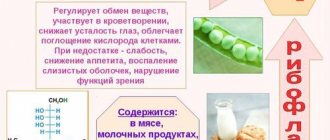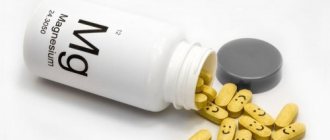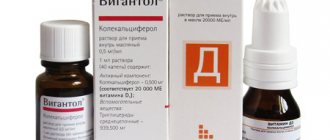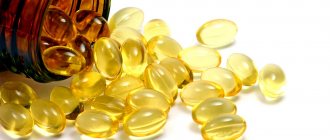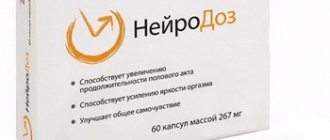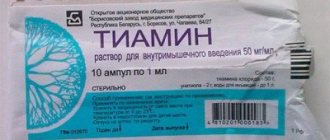Together with an expert, we find out why vitamin K is necessary for the normal functioning of the body, what its daily requirement is and how it interacts with other vitamins.
Vitamin K is a fat-soluble vitamin that comes in two forms. K1 is phylloquinone, found in green leafy vegetables, K2 is menaquinone, found in some animal products. It can also be produced by bacteria living in the human body [1].
The material was checked and commented by Shavkat Nurmatov, gastroenterologist, family doctor, therapist, endoscopist GMS Clinic
Vitamin K helps produce the proteins prothrombin and osteocalcin, which are necessary for blood clotting and bone building. It is found throughout the body, including the liver, brain, heart, pancreas and bones, and is quickly broken down and eliminated naturally. Due to these properties, this element rarely reaches toxic levels in the body even with high intake, as can sometimes happen with other fat-soluble vitamins.
Most people get enough of this substance from food. The recommended daily intake depends on gender and age [2]:
There are medications that affect the absorption of vitamin K in the body. These include antacids (heartburn medications), anticoagulants, antibiotics, aspirin, medications for seizures, high cholesterol and other diseases. They can destroy the bacteria that produce this element in the intestines, thereby potentially reducing its levels, especially if the medicine is taken for more than a few weeks.
Vitamin K is found in many vegetables and fruits, such as spinach, asparagus, broccoli, legumes, and strawberries. You can also get it by eating beef liver and chicken.
© SHUTTERSTOCK
What foods contain vitamin K and how to compensate for its deficiency
Vitamin K1, K2 and K3 - what's the difference?
Vitamin K1 - phylloquinone. Vitamin K1 comes from plant foods, such as leafy green vegetables. Of the entire group, approximately 75-90% of this particular element enters the body. Research shows that vitamin K1, which is found in plants, is poorly absorbed. Of the total amount, the body absorbs only 10% of the active vitamin compound [1]. Better absorption of phylloquinone is ensured by simultaneous consumption of vegetables with certain fats.
Vitamin K2 is divided into several subtypes - menaquinones (MK). Each of them differs in the length of the side chain from MK-4 to MK-13. Sources of vitamin K2 are animal products and fermented foods. The issue of vitamin K2 absorption by the body continues to this day. There is an expert opinion that if K2 is contained in foods with fats, then it is absorbed better, since it has a fat-soluble structure.
Vitamin K3 - menadione - is an artificially synthesized water-soluble analogue of vitamin K. The drug is actively used in veterinary medicine. Human studies have shown that vitamin K3 is harmful. Its effect on the body caused damage to liver tissue and destruction of red blood cells. In this regard, menadione is not prescribed as a prophylactic agent in the form of nutritional supplements. It is used only in the treatment of certain pathologies strictly under medical supervision.
Vitamins (lat. vita life + amines) are low molecular weight organic compounds of various chemical natures that are absolutely necessary for the normal functioning of organisms. They are essential nutrients, because... With the exception of nicotinic acid, they are not synthesized by the human body and come mainly as part of food.
Unlike all other vital nutrients (essential amino acids, polyunsaturated fatty acids, etc.), vitamins do not have plastic properties and are not used by the body as a source of energy. Participating in a variety of chemical transformations, they have a regulatory effect on metabolism and thereby ensure the normal course of almost all biochemical and physiological processes in the body.
Most known vitamins are represented not by one, but by several compounds (vitamers) that have similar biological activity. To name groups of similar related compounds, letter designations are used; Vitamers are usually designated by terms reflecting their chemical nature. An example is vitamin B6, a group of which includes three vitamers: pyridoxine, pyridoxal and pyridoxamine.
There are 13 known essential nutrients, which are certainly vitamins (see table). They are usually divided into water-soluble and fat-soluble.
Classification, nomenclature of vitamins and their specific functions in the human body.
| Vitamin | Vitamers | Active forms of vitamins | Specific functions of vitamins |
| Table section: “Water-soluble vitamins” | |||
| Vitamin C | Ascorbic acid, dehydro-ascorbic acid | Not known | Participates in the hydroxylation of proline to hydroxyproline during collagen maturation |
| Thiamine (vitamin B1 water soluble) | Thiamine | Thiamine diphosphate (TDP, thiamine pyrophosphate, cocarboxylase) | In the form of TDP, it is a coenzyme of carbohydrate-energy metabolism enzymes |
| Riboflavin (vitamin B2 water soluble) | Riboflavin | Flavin mononucleotide (FMN), flavin adenine dinucleotide (FAD) | In the form of FMN and FAD, it forms prosthetic groups of flavin oxidoreductases - enzymes of energy, lipid, and amino acid metabolism |
| Pantothenic acid (obsolete name - vitamin B5) | Pantothenic acid | Coenzyme A (coenzyme A; CoA) | In the form of CoA, it participates in the processes of biosynthesis, oxidation and other transformations of fatty acids and sterols (cholesterol, steroid hormones), in the processes of acetylation, and the synthesis of acetylcholine |
| Vitamin B6 water soluble | Pyridoxal, pyridoxine, pyridoxamine | Pyridoxal phosphate (PALP) | In the form of PALF, it is a coenzyme of a large number of enzymes of nitrogen metabolism (transaminases, amino acid decarboxylases) and enzymes involved in the metabolism of sulfur-containing amino acids, tryptophan, and heme synthesis |
| Vitamin B12 water soluble (cobalamins) | Cyanocobalamin, oxy-cobalamin | Methylcobalamin (CH3B12), deoxyadenosyl-cobalamin (dAV12) | In the form of CH3B12, it participates in the synthesis of methionine from homocysteine; in the form of dAB12, it participates in the breakdown of fatty acids and amino acids with a branched chain or an odd number of carbon atoms |
| Niacin (vitamin PP water soluble) | Nicotinic acid, nicotinamide | Nicotinamide adenine dinucleotide (NAD); nicotinamide adenine dinucleotide phosphate (NADP) | In the form of NAD and NADP, it is the primary acceptor and donor of electrons and protons in redox reactions catalyzed by various dehydrogenases |
| Folate (obsolete name - vitamin Bc) | Folic acid, folic acid polyglutamates | Tetrahydrofolic acid (THFA) | In the form of THFA, it transfers one-carbon fragments during the biosynthesis of purine bases, thymidine, methionine |
| Biotin (obsolete name - vitamin H) | Biotin | Biotin residue bound to the e-amino group of the lysine residue in the apoenzyme molecule | Part of carboxylases, which carry out the initial stage of fatty acid biosynthesis |
| Section of the table “Fat-soluble vitamins (do not dissolve in water)” | |||
| Vitamin A | Retinol, retinal, retinoic acid, retinol acetate | Retinal, retinyl phosphate | In the form of retinal, it is part of the visual pigment rhodopsin, which ensures the perception of light (conversion of a light impulse into an electrical one). In the form of retinyl phosphate, it participates as a carrier of sugar residues in the biosynthesis of glycoproteins |
| Vitamin D (calciferols) | Ergocalciferol (D2); cholecalciferol (D3) | 1,25-Dioxychole-calciferol (1,25-(OH)2-D3) | A hormone involved in maintaining calcium homeostasis in the body; enhances the absorption of calcium and phosphorus in the intestine and its mobilization from the skeleton; influences the differentiation of cells of epithelial and bone tissue, hematopoietic and immune systems |
| Vitamin E (tocopherols) | α-, β-, γ-, δ-tocopherols | The most active form is α-tocopherol | Acts as a biological antioxidant that inactivates free radical forms of oxygen, protects lipids of biological membranes from peroxidation |
| Vitamin K | Phylloquinone (vitamin K1); menaquinones (vitamins K2) 2-methyl-1,4-naphthoquinone (menadione, vitamin K3) | Dihydrovitamin K | Participates in the conversion of preprothrombin to prothrombin, as well as in similar conversions of some proteins involved in the blood clotting process and the bone protein osteocalcin |
Taking vitamins in doses significantly higher than the physiological requirement can lead to unwanted side effects, and sometimes to severe intoxication. Such pathological conditions are called hypervitaminosis. The use of high doses of vitamins D and A is especially dangerous.
Water-soluble vitamins are much easier to remove from the body, and only exceeding the physiological dose by tens or hundreds of times, especially when administered parenterally, can cause the occurrence of nonspecific side effects (nausea, diarrhea, urticaria), which quickly disappear when the drugs that caused hypervitaminosis are discontinued or when the diet is corrected .
The chairman of the expert commission of the English Government Food Standards Agency, Professor Michael Langman, is convinced that “over the past few years we have collected enough evidence that certain vitamins in large doses can be harmful to human health.” See also Vitamin and mineral complexes Fortification of food and water with vitamins Conflicts of vitamins when taken simultaneously Vitamins in the diet of vegetarians and vegans
Daily value of vitamin K for women, men and children
The daily requirement for vitamin K is 120 mcg per day for an adult. Recommended dosages vary from country to country. The European Food Committee (ECF) has determined a dose of 1 mcg per 1 kg of weight. In Germany, Austria and Switzerland, men are advised to take 70 mcg for men, 60 mcg for women.
| Age | Men, mcg/day: | Women, mcg/day: |
| 0-6 months | 2,0 | 2,0 |
| 7-12 months | 2,5 | 2,5 |
| 1-3 years | 30 | 30 |
| 3-7 years | 55 | 55 |
| 7-11 years | 60 | 60 |
| 11-14 years old | 80 | 70 |
| 14-18 years old | 120 | 100 |
| From 19 years and older | 120 | 120 |
| Pregnancy | 120 | |
| Lactation | 120 |
Norms of physiological needs in the Russian Federation (RF, MR 2.3.1.2432-08)
[Video] Vitamin K2: Why, where, how much?
What does vitamin K do in our body?
Blood clotting. The main task of vitamin K is to support normal blood clotting function. Without its participation in catalytic processes, prothrombin and proteins of the coagulation system cannot bind calcium molecules, which is the main condition for the formation of a blood clot.
Increased bone density . Most experts are of the opinion that vitamin K stimulates the growth and development of bone tissue. Studies confirming this were conducted in Japan. Observations were carried out on postmenopausal women for 6-36 months. A review of 12 experiments out of 13 performed showed that additional intake of fetonadione or MK-4 increases bone mineralization. In women, the incidence of fractures of various bones, including the hip and vertebrae, decreased.
The findings prompted new research into postmenopausal women. A medical experiment showed that with a daily intake of 180 mcg of MK-7 for 3 years, it increases bone tissue density and reduces the decrease in vertebral height in the lower thoracic spine [3].
The research results convinced the Council of the European Food Safety Authority to publish conclusions on the importance of vitamin K for maintaining the physiological condition of skeletal bones [4].
In some Asian countries and Japan, the treatment of osteoporosis requires the inclusion of a therapeutic dose of MK-4, which is 45 mg [5].
Reducing the likelihood of cardiac ischemia . Vitamin K is necessary to activate a protein that blocks the formation of calcium deposits on arterial walls. Moreover, research results have shown that these properties are more pronounced in vitamin K2, and not in K1.
Dutch scientists conducted an isolated experiment involving 564 postmenopausal women. It has been found that dietary intake of menaquinone reduces coronary artery calcification [6]. In a study of more than 4,000 men and women over 55 years of age, vitamin K2 was found to significantly reduce the likelihood of massive aortic calcification [7]. One group of subjects was offered 21.6 to 32.7 mcg of menaquinone daily, while the other group received less than 21.6 mcg. As a result, it was possible to establish that in the first group, mortality from coronary disease was lower to 57% than in the others.
Application in cosmetology
The use of vitamin K for cosmetic purposes has shown high results in eliminating signs of skin aging. If a person has impaired absorption of vitamin K, premature aging is especially pronounced. These findings from one study led to the active inclusion of vitamin K in face and body care products.
The Journal of Vascular Research published the results of an experiment in which it was found that vitamin K prevents the development of varicose veins [8]. Cosmetic companies use phytonadione to stabilize the capillary network and strengthen blood vessels. The administration of vitamin K is an obligatory part of the recovery period after laser sessions, cosmetic peelings, and plastic surgeries.
The use of vitamin K in homemade face masks allows you to achieve a positive anti-aging effect:
- Quick morning mask. For the mask, take: a teaspoon of lemon juice, a handful of curly cabbage, a teaspoon of honey, a tablespoon of coconut milk. All components are mixed and crushed in a blender. The mixture can be stored in a glass container in the refrigerator. The prepared composition is used within a week. The mask is applied to the face in the morning for 10 minutes [9].
- Ildi Pekar mask. A professional cosmetologist has compiled his own recipe for a mask that relieves inflammation and redness on the skin. Ingredients: two handfuls of parsley, 2 teaspoons of natural apple cider vinegar, 3 tablespoons of plain yogurt. The ingredients are mixed in a blender. The finished mixture is applied to cleansed skin of the face and neck for 15-20 minutes, then washed off with warm water. The result is a face without redness and skin whitening.
- Cucumber-yogurt mask. In a blender, mix fresh cucumber with 1 tablespoon of natural yogurt. The composition is applied to the face for 15 minutes. Wash off with cool water. Cucumber pulp is rich in vitamins C and K, which block the action of antioxidants, moisturize the skin, and eliminate dark circles under the eyes. Yogurt - removes dead cells of the surface epithelium, nourishes the skin. The result is a moisturized, radiant face, a tightened oval [10].
Types of vitamins
Modern science has discovered 13 vitamins; a person can get them with food, from vegetables, fruits, meat, or from special industrial complexes.
Fat-soluble type
This group includes those substances that dissolve in a fatty environment.
These include the following connections:
- retinol;
- calciferol;
- tocopherol;
- phylloquinone.
Excess fat-soluble vitamins are excreted outside the body. Excessive consumption of these compounds is dangerous to human life.
Water-soluble species
The group includes compounds that dissolve in an aqueous environment. These include vitamin C and B vitamins.
B vitamins are:
- thiamine;
- riboflavin;
- a nicotinic acid;
- AT 5;
- AT 6;
- AT 7;
- folate;
- cyanocobalamin.
These vitamins are very important for humans; they are not deposited in tissues and are easily excreted outside the body.
Vitamin-like
These compounds are classified in a separate group. They do not have the characteristics characteristic of vitamins, but they have some of their properties.
Here, too, there is a division into the ability to dissolve in water and fat.
Fat-soluble: vitamins F, N; coenzyme Q.
Water soluble:
- choline;
- inositol;
- para-aminobenzoic acid;
- L – carnitine;
- orotate;
- pyrroloquinoline quinone;
- pangamic acid;
- B16;
- B17;
- bioflavonoids;
- U.
Symptoms of excess vitamin K
If a person gets vitamin K from food, he is not at risk of experiencing negative symptoms. The threat of side effects is associated with the use of a synthetic analogue - vitamin K3 (menadione).
Menadione in excessive dosages can lead to serious complications:
- An increase in the concentration of vitamin K and, as a result, leads to thrombosis.
- Hemolytic anemia.
- Convulsive toxicosis in children.
- Increased prothrombin.
- Hyperbilirubinemia.
Excess vitamin K3 leads to increased blood viscosity. As a result of these changes, the risk of blood clots increases. If a patient is diagnosed with varicose veins, complications appear - atherosclerosis, thrombophlebitis.
Shortage and surplus
Insufficient vitamin content in the body can lead to quite dangerous diseases, including anemia and chronic adenoiditis. The following symptoms indicate a deficiency of such an element:
- rapid fatigue, even after mild physical exertion;
- violation of the work and rest schedule;
- frequent colds;
- periodic headache;
- increased irritability;
- paleness of the skin;
- muscle aches;
- increased bleeding.
At the initial stage, vitamin deficiency is difficult to diagnose, since the symptoms of deficiency are similar to other hypovitaminosis, as well as pathologies of internal organs. The main difference between vitamin C deficiency is the increased fragility of blood vessels.
When collagen synthesis decreases, vascular walls weaken, which leads to their damage. Corresponding clinical manifestations are nosebleeds, bleeding gums, and bruising under the skin.
No less dangerous is hypervitaminosis C, which is expressed in the appearance of the following symptoms:
- nausea and vomiting syndrome;
- heartburn;
- inflammatory processes in the esophagus;
- diarrhea;
- red blood cell hemolysis (cell destruction);
- disorders of the pancreas;
- formation of stones in the kidneys;
- manifestations of disturbances in the functioning of the heart and blood vessels.
Doctors do not recommend consuming large amounts of vitamin C for women during pregnancy, people suffering from increased blood clotting, thrombophlebitis, thrombosis, or diabetes.
Vitamin K for newborns: why is it so important in the first months of life?
A person receives natural vitamin K through food. Newborn children are provided with a small supply of it. A lack of vitamin K in a baby’s body can cause bleeding, including internal bleeding.
What's happening? Insufficient vitamin K leads to the development of hemorrhagic disease in infants. In this case, the newborn’s body cannot stop the bleeding on its own. Pathology manifests itself on days 1-7 of life. Bleeding occurs from the vessels of the intestine or brain. In severe cases, brain damage and death are possible. If an infant does not receive vitamin K at birth, the disease can manifest itself at any time during the first 6 months of life.
Why are infants more likely to be vitamin K deficient? Newborn children are at risk of getting hemorrhagic disease, regardless of gender or nationality. The risk decreases after 4-6 months, when complementary foods are introduced into the diet and the intestinal flora begins to independently synthesize vitamin K.
Causes of vitamin K deficiency in newborns:
- Insufficient supply of vitamin K from the mother through the placenta.
- Lack of specific intestinal bacteria that can produce their own vitamin K.
- Low vitamin K content in breast milk. Breastfed children receive very little vitamin element.
What can you do to prevent vitamin K deficiency in a newborn? In modern pediatrics, an effective remedy has appeared against vitamin K deficiency in infants - vaccination. A vitamin K injection is given into the thigh muscle immediately after birth. To ensure rapid contact between mother and newborn, the vitamin K injection can be delayed 6 hours later.
US pediatricians follow the recommendations of the American Academy of Pediatrics and administer a single dose of 0.5 to 1 mg of vitamin K1 immediately after birth [12].
The development of late deficiency in children who were not given a vitamin K injection immediately after birth is observed 81 times more often than in babies who received a vitamin K injection.
From 30 to 60% of newborns experience bleeding in the brain of varying severity. This condition is common in children who are exclusively breastfed and have not received a vitamin K shot.
How to determine deficiency in an infant? Symptoms of vitamin K deficiency in a newborn:
- The appearance of bruises on the face and head.
- Bleeding from the nose or umbilical wound.
- Pallor of the skin, oral mucosa, and gums.
- Yellowing of the whites of the eyes after the first three weeks of life.
- Vomiting blood.
- Dark or black stools—tarry stools.
- The appearance of signs of cerebral bleeding - convulsions, moodiness, severe drowsiness, severe vomiting.
[Video] Vitamin K for newborns: protection against hemorrhages, K1 and K2 - world practice:
What vitamin complexes should I buy?
Having figured out what vitamins are for, you need to understand that in order to get rid of a deficiency, it is unlikely that it will work only with the help of vegetables, fruits, fish and meat. Sometimes only taking special complexes helps solve the deficiency problem.
For immunity
Fruttilar Evalar: is a source of vitamins such as ascorbic acid, tocopherol, elderberry extract. They are in the form of lozenges that can be chewed like regular marmalade.
Multi Tabs Immuno plus: contains vitamins, minerals, probiotic with lactobacilli.
Complivit: contains vitamins, microelements, and has a low cost.
Centrum: used in children over 12 years of age, it contains a complex of vitamins and microelements. An important advantage is the large number of antioxidants.
Supradin Immuno Forte: echinacea, vitamin C, zinc, propolis.
For vision
What vitamins are there for the eyes? Okuwait Forte is recognized as one of the most popular. Contains lutein, zeaxanthin, carotenoids. Protects the retina from negative influences, reduces the risk of developing changes, and stops inflammatory processes.
To maintain beauty
Doppelhertz: accelerates metabolic processes, stimulates cellular renewal. Works to improve the condition of the skin, stimulate hair growth, and strengthen nails.
Solgar: contains methylsulfonylmethane, which transports sulfur, collagen, keratin. The presence of ascorbic acid, zinc, and copper enhances the positive effects of the drug. A course of treatment increases the elasticity of the skin and regulates the functioning of the sebaceous glands.
Merz: vitamins contained here (L-cysteine, iron, B vitamins, ascorbic acid, retinol) perform various functions. Dragees help increase the strength of connective tissues and stimulate cellular renewal processes.
Vitrum Beauty: contains 10 vitamins, enhanced with bioflavonoids and amino acids.
Complivit Radiance: includes green tea extract and 10 vitamins. Used to strengthen hair follicles and eliminate dandruff.
For men's health
Solgar for men: helps in easily overcoming stress, normalizing hormonal levels, increasing performance, strengthening the immune system.
Doppelherz for future dads: all the vitamins necessary for conception are collected here. Contains components to improve prostate function.
Doppelgerz Spermactive: increases libido, increases sensitivity during sexual intercourse, strengthens erection, improves the quantity and quality of sperm, stimulates their motility.
Pharma Honey "Men's Formula": aimed at increasing the body's immune forces, normalizing blood circulation processes, increasing vitality, normalizing the functioning of the cardiovascular system. Helps with high fatigue, decreased intellectual capabilities, and memory loss. Contains 26 minerals, vitamins for the male body, valuable plant extracts.
Pharma Med "Male Formula" Forte: prevents the occurrence of sexual dysfunction, improves blood circulation in the pelvic organs, enhances potency, increases the duration of sexual relationships, and prevents premature ejaculation.
Men's Multivitamin Formula: Created to support the health of people involved in sports. Contains 12 vitamins, 9 elements. Increases endurance, normalizes sleep, increases energy, vigor, and normalizes the functioning of the reproductive organs.
Parity Evalar: designed to stimulate potency, contains roots of Eurycoma longifolia, yohimbe. Helps normalize testosterone production and stimulate libido.
For children
Doppelhertz Kinder: These vitamins are an excellent choice for keeping children's bodies healthy. Contains the entire group of B vitamins, glycine, ascorbic acid. The complex has a pleasant taste of raspberry and orange, which does not create problems during use. Taking vitamins helps strengthen the nervous system, increases mental activity, normalizes sleep, stabilizes the psycho-emotional background, and stabilizes metabolic processes in the brain.
Fruttilar company Evalar: is produced in the form of marmalade, reminiscent of chewing candies. Contains B vitamins, retinol, ascorbic acid.
Multi Tabs Immuno Kids: used in children from three years old. Contains B vitamins, tocopherol, ascorbic acid, vitamins K, D, 6 minerals, lactobacilli.
Vitrum Kids: approved for use in children over 3 years old. It looks like gummy animals with a pleasant taste. Contains a wide range of vitamins.
Pikovit: there are several varieties approved for use from 1, 3, 4 and 7 years.
Adult complexes
Doppelhertz A to Zn: used to restore people who often experience mental and physical stress. Can be used to prevent the development of deficiency conditions. Contains 13 vitamins. 11 minerals. Works to strengthen the immune system, increasing the body's resistance to stress.
Selmevit: suitable for people recovering from surgery, injuries, and chronic pathologies. The drug contains vitamins and minerals that increase the body's resistance to negative factors.
Undevit: an inexpensive drug containing calcium, ascorbic acid, retinol, tocopherol, B vitamins and vitamin P. Indicated for use by weakened people for recovery after illnesses. Suitable for use in old age to establish normal metabolism.
Solgar Multi-1: differs from other drugs in that all its components are presented in easily digestible forms. Contains a line of basic vitamins, as well as chromium, zinc, selenium, magnesium, iodine, rutin, copper, bioflavonoids. For ease of absorption by the body, organic betaine hydrochloride is included in the composition.
Multi tabs: contains antioxidants, without which the proper functioning of the heart, urinary and nervous system organs is impossible. The drug is used to strengthen the body’s immune forces and increase its resistance in the fight against stress.
Vitrum: used for the prevention and treatment of vitamin deficiencies. It is often prescribed to stabilize the body’s functioning after cancer.
Complivit: contains vitamins, minerals, supplemented with cobalt, without which the full functioning of the hematopoietic system and the processing of nutrients into energy is impossible.
Complexes for pregnant women
Doppelgerz active for expectant mothers: balanced for women who are preparing for conception.
Elevit: contains an increased amount of magnesium, necessary for relaxing muscle muscles. Therefore, the drug is used to prevent miscarriage. Contains a level of folic acid sufficient for normal fetal development.
Multi Tabs Prenatal: contains the main forms of vitamins, as well as minerals - magnesium, iodine, supplemented with the right amount of folic acid.
Fruttilar from Evalar for pregnant women: contains a whole complex of vitamins and minerals. Suitable for use immediately after conception, as well as at the planning stage of pregnancy, during lactation. It is produced in an attractive form of marmalade berries, which does not create problems with administration even with severe toxicosis.
Complexes for maintaining vigor
Berocca: consists of components that support mental activity at any age, reduce the speed of reactions, and increase energy production by cells.
Alphabet Energy: all components are divided into three groups of components that need to be taken in the morning, lunch and evening. This is done in order to avoid conflict between substances and improve the degree of absorption by the body. The complex maintains human activity at a high level throughout the day.
Gerimax Energy: helps in the fight against fatigue, supports vitality. Vitamins and minerals are supplemented with extracts of green tea leaves and ginseng root.
Biorhythm Antistress company Evalar: capsules are taken in the morning and evening to restore the body’s biological rhythms, get rid of fatigue, normalize sleep, and improve its quality characteristics.
Complivit Superenergy: additionally contains guarana, which increases the level of energy in the body, relieves increased anxiety and chronic fatigue.
Doppelhertz Energotonic: has a varied composition, including vitamins, minerals, bioflavonoids. Works to combat fatigue, increases activity levels, and accelerates recovery from illnesses.
Vitamins are important components of human life. Without a sufficient amount of them, it is impossible to achieve effective and complete functioning of the body. Therefore, it is so important to monitor their quantity, avoid deficiencies, promptly adjust the diet, and take special complexes.
Also read: What to do at the first signs of sinusitis? Types of disease and methods of treatment
Comments
Vitamin K and blood clotting factor
Vitamin K regulates the formation of several blood clotting factors in liver tissue:
- II - prothrombin.
- VII - proconvertina.
- IX - Christmas factors.
- X - Stewart-Prower factors.
The main role of vitamin K is to participate in the carboxylation of glutamate residues in the N-terminal regions of these protein compounds, which leads to the formation of γ-carboxyglutamate.
Prothrombin is a vitamin K-dependent plasma protein, without which blood clotting is impossible. Other vitamin K-dependent factors include proteins C, S and Z, of which proteins C and S are anticoagulants. Metabolic pathways contribute to the preservation of vitamin K in the blood. As soon as the reaction of the formation of blood clotting factors with the participation of vitamin K has occurred, vitamin K epoxide is formed. It is further transformed into the active enzymatic form - vitamin K hydroquinone.
Functions of vitamins
Vitamins are components of enzymes and hormones; only at their required level can the body launch a full-fledged metabolic process.
What is the biological role of vitamins:
- hematopoiesis;
- protecting the body from toxic effects and harmful effects of radionuclides;
- ensuring the full functioning of various systems of the human body.
| Name of the compound, its daily dosage | Functions performed | Where can I find |
| Beta-carotene (1300 mcg) | · work of immunity; maintaining vision; · maintaining healthy skin | Bright vegetables, fruits, sweet potatoes, mangoes, spinach, carrots |
| Retinol (1000) | · skin health; · strength of bones, teeth; maintaining healthy mucous membranes | Dairy products, chicken, fish, meat |
| B1 (1.8 mg) | · breakdown of carbohydrates; energy production | Cereals, legumes, meat, nuts |
| B2 (20 mg) | · combating the effects of free radicals; control over the formation and growth of red blood cells | Yeast, organ meats, almonds, mushrooms, broccoli, spinach, eggs, whole grain bread, milk |
| B3 (5 mg) | · produces serotonin, melatonin; · reduces the level of “bad” cholesterol | Beets, green vegetables, eggs, dairy products, fish, yeast, chicken, meat |
| B5 (5 mg) | · responsible for memory; · synthesizes sex hormones, red blood cells; Regulates the functioning of the gastrointestinal tract | Meat, chicken, unprocessed grains, turkey, whole grains, vegetables, egg yolk, vegetables |
| B6 (2 mg) | · immune support; hemoglobin production; · takes part in protein metabolism | Bananas, avocados, nuts, beans, meats, whole grains |
| B7 (50 mcg) | · skin protection; · reduction of mental tension; glycogen metabolism | Whole grains, mushrooms, cauliflower, nuts, yeast, eggs, legumes, bananas |
| B9 (400 mcg) | · cellular construction; · reducing the risk of developing heart disease and weakening of blood vessels; · reducing the likelihood of fetal defects | Spinach, broccoli, leafy vegetables, yeast, banana, mushrooms, melon, lettuce |
| B 12 (3 mcg) | · protection against the development of cardiovascular diseases and cancer | Dairy products, beef, fish, eggs, chicken |
| Ascorbic acid (90 mg) | · strengthening the immune system; · protection of the circulatory system; · preventing the negative effects of free radicals; · protection of cells from premature withering; · removal of toxins | Fresh fruits, vegetables |
| Vitamin D (15 mcg) | Regulates the absorption of phosphorus and calcium | Produced in the skin under the influence of sunlight. Liver, yolk, beef |
| Tocopherol (15 mg) | · protection of cells from oxidative processes; · work of immunity; · prevention of the development of senile dementia | Seeds, vegetable oil, nuts, spinach, melon, coriander, apricots, cabbage |
Precautions and contraindications
Warfarin , as well as other anticoagulants, reduce the effectiveness of vitamin K, and therefore inhibit the synthesis of prothrombin. When prescribing anticoagulants, it is mandatory to take a sufficient amount of vitamin K [14].
Antibiotics can negatively affect intestinal microflora. When the activity of bacteria that synthesize vitamin K is suppressed, its level in the blood decreases. This effect is especially noticeable when prescribing cephalosporin drugs, which inhibit the effect of vitamin K in the body. Additional vitamin K intake is necessary if antibiotic therapy lasts more than several weeks [15].
Bile acid sequestrants are prescribed to patients to reduce cholesterol levels. The effect is achieved by suppressing the absorption of bile acids. Due to this, there is also a violation of the absorption of vitamin K and other fat-soluble vitamin compounds [16].
Orlistat is a weight loss drug. The active components cause a decrease in the absorption of fats contained in foods. In this regard, the absorption of fat-soluble vitamins, including vitamin K, is reduced. If Orlistat is combined with Warfarin, an increase in prothrombin time is noted [17].
Cooking tips and tricks
Ascorbic acid is one of the most unstable vitamins among all useful elements. The negative impact comes not only from high temperatures during cooking, but also from freezing food containing acid.
In order to preserve the beneficial properties of products with ascorbic acid, it is recommended to follow the following rules:
- store food in a place where open sunlight does not penetrate and where it is cool;
- do not use metal utensils during cooking, which contribute to the oxidation of the vitamin, reducing its beneficial properties;
- It is better to cook food by steaming, in a double boiler, or in a frying pan under a lid with the addition of a small amount of water;
- When cooking vegetables containing vitamins, they should be thrown into boiling water, and not brought to a boil in cold water;
- prepared meals with appropriate ingredients are not heated;
- cut, salt, season salad and vegetables immediately before consumption.
By following these simple recommendations, you can preserve the beneficial properties of vitamin C by 30%.
Due to the fact that this element belongs to the group of acids, it is not recommended to eat food containing it on an empty stomach. This is especially true for people with a weak stomach, which can cause irritation of the mucous membranes of the organ. It is better to take such foods together with starch-containing foods, for example, potatoes, bananas.

